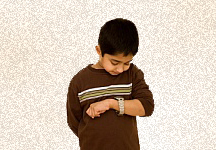 The age-old “time-out” technique is not so effective—and it can even lead to harmful side effects. Author Kimberley Clayton Blaine explains why parents should put this punishment go-to to rest for good…and offers some simple steps for a better alternative.
The age-old “time-out” technique is not so effective—and it can even lead to harmful side effects. Author Kimberley Clayton Blaine explains why parents should put this punishment go-to to rest for good…and offers some simple steps for a better alternative.
As parents, we’ve all been there. When the kicking, screaming, and other tantrum-y behaviors start, the easy fix is often a threat (or an order) to go to time-out. And chances are, you picked up this habit from your own parents. But according to parenting expert and author Kimberley Clayton Blaine, too many time-outs may be ineffective at best—young children simply don’t understand the concept—and downright harmful at worst.
That’s right. Kids subjected to repeated time-outs may develop poor emotion control because they are left alone without support and validation when they need it most.
“The misuse of a time-out is not only punishing but also alienating, and may spark a long-term physiological response,” explains Blaine, licensed family and child therapist, mother of two boys, and author of the new book The Go-To Mom’s Parents’ Guide to Emotion Coaching Young Children (Jossey-Bass/A Wiley Imprint, 2010, ISBN: 978-0-470-58497-2, $16.95, www.TheGoToMom.com). “In a worst-case scenario, they could internalize the emotional pain in order to cope, which can eventually turn into early childhood depression.
“Empathy is truly the foundation for effective parenting, and it is also necessary in creating a stronger bond between parent and child,” she adds. “Time-outs are the antithesis of that.”
Blaine advocates an alternate method that takes into account a child’s developmental limitations and that serves as guidance rather than punishment. For children over two, she suggests using a “cool-down” or “thinking time” instead. Not only is this method gentle, it keeps the parent by the child’s side to help him learn to calm himself down and think through what happened.
(Incidentally, for babies two and under, Blaine recommends distraction and redirection instead. At this age your baby is simply too young to understand the concept of a thinking time; instead, give him a new item of interest or move him to an exciting location.)
So, let’s assume your child is older than two and you’re ready to kick the old-school habit of time-outs to the curb. The following steps teach you how to use a cool-down or thinking time successfully:
- Get down at your child’s level. Be sure to maintain good eye contact; give a warning and ask if what she is doing is “okay” or “not okay.”
- If your child doesn’t calm down or stop the unacceptable behavior, then lead him to a “quiet area” or “thinking area.” Sit with him and offer assistance and love. Remember, this is not a punishment.
- Be aware that time is not important—having your child calm down is. Disregard the “one minute times your child’s age” stance that most use as a guide. Don’t give a five-year-old “five minutes to think”; sometimes the older child needs only a minute or two to come up with a better solution. On the other hand, a younger child may need to cuddle or sit with you for ten minutes until she’s calm.
As you’re sitting there, empathize, validate, and reflect what you see. An understood child is less likely to be fraught.
- Once your child is calm, ask him to tell you “what’s wrong” or “what’s going on.” Restate the problem again more clearly if he has difficulty.
- Ask your child, “What will you do differently next time?” Name the expected behavior if she doesn’t know.
- Thank your child for helping you come up with a solution. It’s important that he hears this positive reinforcement.
- Set the expectation for the future by wrapping up with, “If you don’t listen next time, what will happen?” Inform your child that you will take actions to help and that you will not tolerate unacceptable behavior.
“Responding to your child in a reasonable, calm, and patient manner is absolutely vital in building a connection,” says Blaine. “And, after all, connection is the key ingredient in helping guide our children. Punishment, on the other hand, forces a disconnection that undermines the goal of helping them someday become independent.”
About the Author:
Kimberley Clayton Blaine, MA, MFT, is the executive producer of the online parenting show www.TheGoToMom.TV and author of The Go-To Mom’s Parents’ Guide to Emotion Coaching Young Children and The Internet Mommy.
Kimberley is a national child development expert and a licensed family and child therapist specializing in working with children newborn to six years old. Kimberley is currently the social marketing director for a Los Angeles-based early childhood mental health campaign (Project ABC) funded by the U.S. Department of Health and Human Services. She has launched a national campaign to help American parents be all that they can be in order to give their children a healthy and fair start. You might have seen Kimberley review products, discuss the perils of parenting, blog, vlog, and take on mommypreneurship across the Internet.
